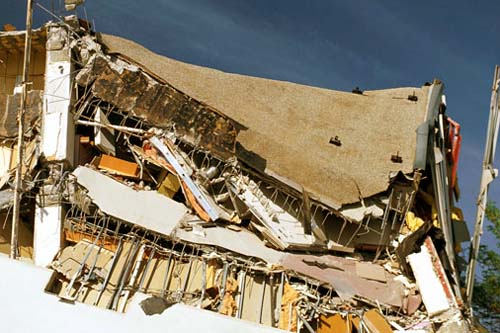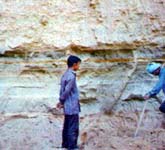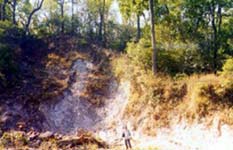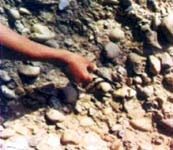Dec 07, 2025
Dec 07, 2025
The earth trembles! The very thought of an earthquake sends a chill up the spine. Many human races and settlements have perished in this natural fury. Since time immemorial man has been trying to find ways to predict an earthquake. Seismology: the science of study of earthquakes indicates that although an accurate prediction is not possible, the probabilities of a future earthquake can be worked out. A probe into the past earthquakes showed that major earthquakes recur after a gap of 100 years or more. In order to workout the probability of an earthquake in an area one of the options with the seismologists is to study the earthquakes of the geological past. Instrumental and historical records and geological evidences are used to identify the past earthquakes in a given area. Since the Seismograph, the instrument to study the earthquakes was developed just more than a century ago there is no question of an instrumental record beyond that. Historical record too has a limitation. Records of earthquakes in the history are only scanty and do not go beyond 500 years. Mentions of earthquakes older than these are available in the religious scriptures, but are difficult to confirm. The science of Tell-tale marks Yes definite tell-tale marks have been left by some earthquakes older than 500 years. Study of these marks is a comparatively new science, the paleo-seismology. The common tell tale marks or the signatures of the devastating earthquakes are found today in the form of active faults; shifting of river courses; tilting of beds of rocks; displacement of strata; liquefaction of sediments till they cut across the strata as a sand dyke; sand blow; sudden change in sedimentation pattern in lakes; co-seismic landslides etc. Tell-tale marks decipher paleo-earthquakes Geology is closer to forensic science. The geologists sniff around the area to search the clues for the past events. For example a fault can sometimes open the pages of the earth's history to indicate an earthquake that had visited the area. As the earth cooled down from the gaseous mass it retained in its womb the geothermal energy. Due to this heat inside the earth lots of stresses develop. The surface of the earth appears to be tranquil, but the depths are always under turmoil. These stresses within the earth manifest in the form of geologic structures. One of them is a fault. It is the fracture surface along which the rocks have been relatively displaced. The energy within the earth is also released as earthquakes and often accompanied by faulting of the strata. However, all faults need not be earthquake generated. They can occur due to other tectonic reasons as well. In case a fault displays movement during an earthquake it is considered to be an active fault. San Andreas Fault in California, USA is one such example of a fault that is still active. While searching for the clues for the past earthquakes the first step a geologist takes is to locate and identify an active fault. Thereafter detailed studies are under taken. There could be series of faults generated by the past earthquakes. In order to ascertain the number of displacements along an active fault a five to six meters deep trench is excavated across the fault zone. Inside the trench geologist can make out the number of times the fault movement has taken place. These are indicative of the number of past earthquake events. The magnitude of the past earthquake is judged by the amount of relative displacement shown by the fault. Using various dating techniques the age of the sediments of the rocks displaced by the fault is then determined. Seismologists of the US claim to have identified large earthquakes that visited Washington and Oregon in the pre-historic period. The buried forests in these apparently calm areas have trees that occur at much higher elevations. It was found that these trees were torn by the earthquakes in the past and swept to lower elevations with co-seismic landslides. Tell-tale marks from India A major breakthrough has recently been made by Rajat Majumdar of Department of Geo-und Umweltwissenscahften, Geologie, Ludwig-Maximilians Universitat, Munchen, Germany. In a paper recently published in an international journal, 'Sedimentary Geology' he claims that India was tormented by the earthquakes even much before the collision of the Indian and the Asian plate some 120 million years ago. Sedimentary rocks are normally deposited layers after layers in the basin. Prior to their compaction and conversion to rock if an earthquake occurs there are chances of deformation of these sediments. Rajat and his colleagues have found such deformational structures (seismites) from the rocks of Chaibasa Formation (2100 to 1600 million years old) of eastern India. It is interesting to note that Chaibasa Formation is underlain by volcanic rocks which have been dated as 2100 million years old. In other words the sediments of Chaibasa Formation were being deposited in a basin affected by active volcanism. In such areas high intensity earthquakes do occur. Paleo-seismological studies have also been initiated in India too. The scientists of the Physical Research Laboratory (PRL), Ahmedabad have been able to date a fault in Nainital, a hill resort in Uttaranchal. The fault dates to 40,000 years and originated presumably due to an earthquake. Locating an active fault in a mountain terrain like the Himalayas is difficult as most of the faults are deep seated. Researchers at the Geological Survey of India (GSI) have reported recent movement along the Karakoram fault in Ladakh. Whether it is an active fault or a tectonic feature is being ascertained. Prabhas Pande, Director of seismology in the GSI says that the active faults in the Himalayas need to be treated with caution, because all such faults may not be co-seismic. The layers of strata in the sub-surface carry films of water between the sand layers known as groundwater. The shaking earth causes liquefaction of sand layers. Groundwater present in these layers aids in liquefaction of the sand layers. The liquefied sand moves to surface through weak planes like the toothpaste coming out of the tube and often cuts across the rocks as Sand Dykes. One such dyke has been reported in the zone of Yamuna Tear near Paonta Saheb in H.P. by D.D. Joshi, a seismologist from GSI and his team mates. Above images courtesy GSI An active search for tell tale marks is on. GSI has gathered evidences that in Yamuna Valley , Uttaranchal and in Baspa Valley , Himachal Pradesh, Madurai in Tamilnadu and Shillong in the northeast have tell tale marks in the form of seismites indicative of prehistoric earthquakes. The active fault (Yamuna Tear) near Paonta Saheb in H.P. along the course of Yamuna River shows many tell-tale marks like sand dykes, cliffs showing vertical movement and shattered boulders in the tear zone, pointing towards an earthquake that probably struck the area some 800 years before present. Shillong Plateau was particularly studied by B.S.Sukhija of National Geophysical Research Institute, Hyderabad. His studies highlighted the change in the course of Krishnai River a tributary of Brahmaputra. As a consequence of Shillong earthquake (M 8.7) of 12 June, 1897 a fault movement caused the shift in the course of the river. Sukhija identified the liquefaction structures in the rocks of the area. These structures were dated which coincide with the earthquake period. His studies also proved that the area was quaked 500, 1000 and 1500 years before present. (1950 is taken as a reference year. The studies suggest recurrence period of 500 years for earthquakes of such magnitude. Similarly Sukhija's studies show that Killari (Latur) area of central Indian Peninsula was not rocked for the first time in 1993, but damaging earthquakes had taken place in the area some 200 years ago too. An earthquake that struck Kutch in Gujarat in 1819 left a mound like structure in the channel of Pharran River. It was found that this mound was 80 km long and up to six meters high at some places. Presuming it to be a curse of the god it was locally named "Allah bund'. The teams of geologists investigating the Kutch (Bhuj) earthquake of 26 January 2001 found a number of liquefaction features in the form of sand blows, ground fissures, mud craters and subsidence craters etc. 



Sand dyke across Quaternary sediments, Yamuna Tear zone.
Vertical cliffs due to Yamuna Tear
Shattered boulders in the Yamuna Tear zone.
The search for tell tale marks of earthquakes is on in India and in many parts of the world. Since the theory of Uniformitarianism says that present is a key to the past and the past is a window for the future, the seismologists strive to build up a picture of earthquakes that occurred in the distant geological past through historical times to present.
We shall read more about some devastating earthquakes that shook our sub-continent in the past.
20-Aug-2006
More by : V. K. Joshi (Bijji)